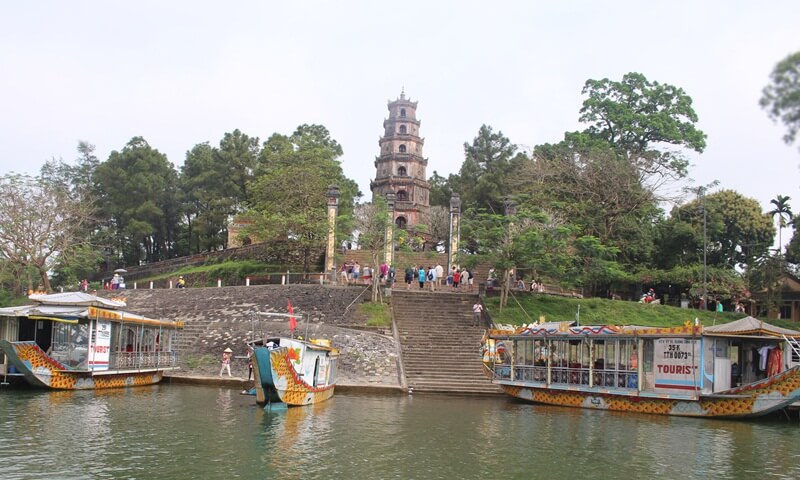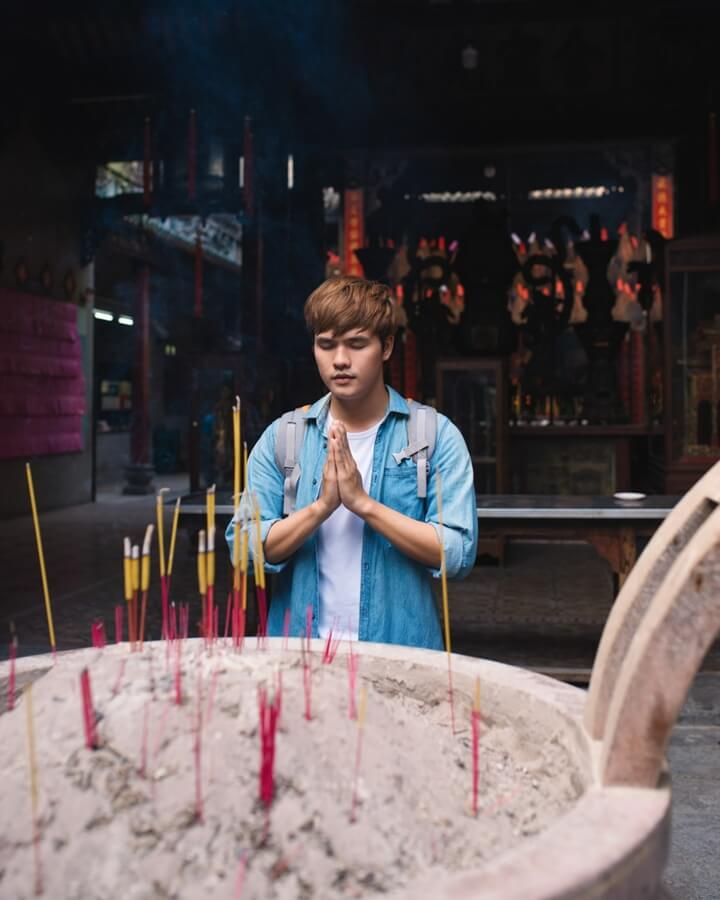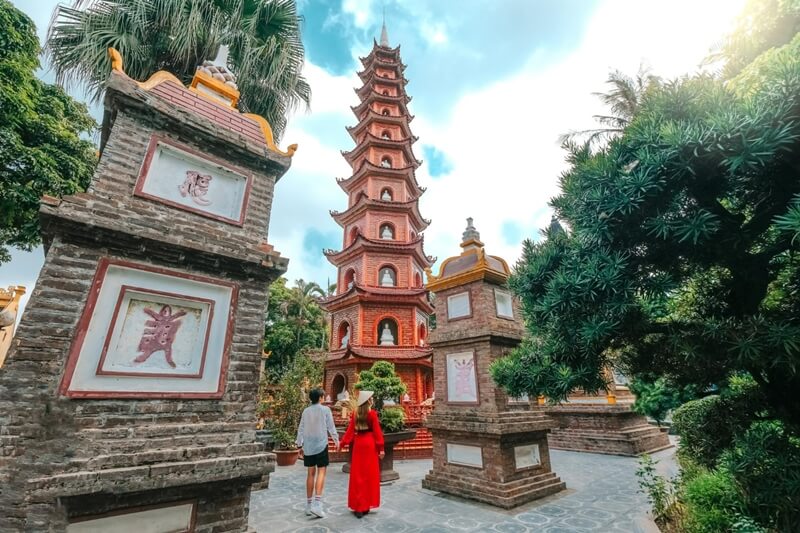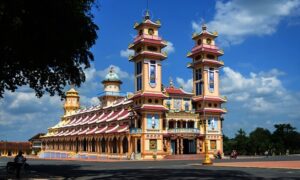Religious travel is an exciting activity in Vietnam. You can visit hundreds of temples in this beautiful country.
Here are the well-known ancient temples that you may like to explore.
1. Thien Hau Temple: 250-year-old Chinese Temple in Saigon
Thien Hau Temple is one of the oldest Chinese temples in Saigon, built in 1760.
Located at Nguyen Trai Street, District 5, Thien Hau Temple has played an essential role in the cultural life of Chinese people living in Ho Chi Minh City since ancient times. The pagoda was recognized in 1993 as a national architectural and artistic vestige.
Over hundreds of years of ups and downs, this religious site has been restored many times but still retains the inherent architecture that creates its own identity. The pagoda was built according to the Chinese characteristics, carrying an Asian style with a three-door gate, stylized architecture with a central entrance, and two corridors on both sides.
The central part of the temple is the main sanctuary for religious activities. Typically, in the middle of this area is a space that allows light, air, and smoke to escape. Along with the central place are two separate paths, creating ventilation so visitors can move quickly on crowded days.
The main hall houses a giant statue of Thien Hau. The light is harmoniously designed to give the feeling of being lost in paradise, and you will have a deep impression when you step inside the temple.
Another typical feature of this temple is its construction using Chinese materials, from bricks to tiles. The large and small statues along the roof will give you holy feelings. Learning about the story behind these statues will also be interesting.
In the early days of spring, especially during Tet in Vietnam, Thien Hau Pagoda welcomes many tourists to pray, bless, or wish for good things for a happy new year. Not only people living in Ho Chi Minh City but also foreign tourists come to visit and learn about the temple’s outstanding history and architecture.
Visitors are so crowded. After a few minutes, the temple workers remove the incense sticks. So, when you burn incense to wish, use 1 or 3 sticks, not too many.
Ba Thien Hau Pagoda is a place of spiritual and cultural activities of great significance to Chinese people in Ho Chi Minh City and surrounding areas. This temple is also an architectural monument of high technical and artistic value, attracting many domestic and foreign tourists. Once you set foot here, you will feel ancient, solemn, and serene, which is rare anywhere.
2. Mia Temple: Holding the Most Artistic Statues in Vietnam
Mia Temple (another name Sung Nghiem Tu) is in Duong Lam Village, Son Tay District, Hanoi, Vietnam. Formerly, this area was called Cam Gia; Nom’s name was Mia, so this temple was known as Mia temple.
From the outside, the three-door gate of the pagoda is under the canopy of an old banyan tree over 400 years old, looking very ancient and profound.
This site holds the most artistic statues in Vietnam, published by the Vietnam Record Book Center. On the statues, each of them has a look, but all show a solemn, serene appearance.
The holy altar of the Holy Sage (Duc Thanh Hien) is on the temple’s important side.
At Thuong Pagoda (Upper one), people also see the caves with many statues. Quan Yin of the South Sea (Quan Am Nam Hai), a rare statue in the temples in the North and the whole country, can be found here.
Also, Quan Am Nam Hai Satue, at 0.76m high, is considered a masterpiece. The people often call Thi Kinh. The statue depicts a delicate woman with a sad face hugging a cute baby. The lines carved are soft, elaborate, comfortable in posture, and lively in spirit.
In the hallway on the left are 9 Arhat (La Han) statues, which were created to cover different facets, but all have benevolent compassion.
The corridor on the right has nine other Arhat. Also, in the Trung temple (the Middle one), there are two giant statues of Dharma protectors: a statue of the good (on the left) and a statue of the evil (on the right). Besides, you can see a 13-meter-high Lien Hoa Stupa in the garden, used to worship Xa Loi Buddha.
With its unique architecture and valuable sculptures, Mia Temple has been ranked by the Ministry of Culture, Sports, and Tourism as a national architectural and artistic monument.
3. Tran Quoc Temple: The Most Beautiful Buddhist Place in Vietnam
Tran Quoc Pagoda is on the island east of West Lake and is listed as the most beautiful temple in Hanoi, Vietnam.
The correct location of Tran Quoc pagoda is on Thanh Nien Street (Ba Dinh District, Hanoi), belonging to the Bac Tong sect. The temple complex consists of many levels with three main buildings, namely Tien Duong, Thieu Huong (the burnt incense house), and Thuong Dien (the upper temple), connected in the shape of the word Cong (工).
With a history of 1,500 years, the temple was the Buddhist center of the Thang Long Capital in the Ly and Tran dynasties. Royal kings visited and worshiped at the Tran Quoc pagoda on the full moon and during the Tet holidays.
In 2003, the pagoda inaugurated the Luc Do Tower, which is 15m in height, has 11 floors, and adorns 66 statues of Amitabha Buddha images with precious stones. At the top of the tower is a Cuu Pham lotus flower carved with beautiful rock.
The main facade of the temple Tran Quoc is organized like a blooming lotus. Inside, the pagoda also retains many statues of Buddha and Bodhisattva of artistic value, notably the statue of Shakyamuni Buddha (Phat Thich Ca) that entered Nirvana with gold- lacquered appearance. The temple is also currently keeping 14 old steles.
When visitors come to the temple, they pray to the Buddha and immerse themselves in the art space of nature in harmony. The ancient moss-covered tile roof helps travelers feel gentle and quiet when sightseeing there.
The Ministry of Culture and Information recognized the temple as a National Cultural and Historic Site in 1962. Every year, many Buddhists attend the ceremony at this site, a tourist attraction in Hanoi for tourists from within and outside Vietnam.
> You may want to see the spiritual attractions in Hanoi.
4. Thien An Temple: A 300-year Ancient Temple
Thien An Temple was built at the end of the 17th century on a mountain of the same name on the banks of the Tra Khuc River, on the way to the famous war relic – My Lai Massacre.
Thien An Pagoda, one of Quang Ngai’s oldest, was built between 1694 and 1695. It is located in Tinh An Dong Commune and sits 100 meters high on a mountain surrounded by one hectare of forest.
Legend has it that the mountain was initially home to wild animals and tigers, with people only gathering firewood at its base. One day, locals discovered a trail leading up to Zen master Phap Hoa, who taught them about Buddhism and human life. This led to the construction of the temple.
The temple’s reputation reached Lord Nguyen Phuc Chu, who in 1717 granted it the rank “Sắc Tứ Thiên Ấn Tự.” The temple is also known for the “Buddha well,” which, according to legend, was dug with divine assistance. The well is 21 meters deep and more than 2 meters in diameter.
Besides, the large old bell at the temple, cast in Chi Tuong village, reportedly only rang once the monk Bao An prayed, making it sound throughout the region.
Thien An Temple is a sacred religious place that the locals visit during the full moon, the first day of the lunar month, and the Lunar New Year.
The Ministry of Culture, Sports, and Tourism declared it a National Historic Site in 1990. Also, you can see the tomb of patriot Huynh Thuc Khang in the temple area.
5. Thien Mu Temple: The Peaceful Religious Site

Thien Mu Temple (Linh Mu) is on Ha Khe Hill, on the left bank of the Perfume River in Hue City, Vietnam. The pagoda was built in 1601 and ranked among the 20 famous landscapes of Hue with the poem “Thien Mu Chung Thanh” (means the sound of Then Mu bell) composed by King Thieu Tri.
The most famous in the temple complex is the Phuoc Duyen Tower. The tower near the Great Gate was built in 1844, is 21 m high, and has seven floors. Each floor of the tower has a Buddha image. Inside is a spiral staircase leading to the top floor, where a golden Buddha statue used to be. The two sides of the tower are the majestic bronze bell and the holy turtle houses.
Some areas, such as Dai Hung, the hell god, and Quan Am Temples, were severely damaged. Over the years, the authorities have restored and repaired many items to meet visitors’ needs. This Buddhist temple has fewer statues than the other temples.
When you travel to this pagoda, you can see an Austin car—a relic of the Venerable Quang Duc. The Austin car was in the parade carrying the Venerable Quang Duc to the self-immolation site on June 11, 1963, in Saigon.
Many historical researchers evaluate the overview of Linh Mu as a palace of kings and mandarins in Hue in the past. The temple has been around for hundreds of years and has the most beautiful architecture and scenery in Hue City.
Located on the banks of the poetic Huong River, Thien Mu Temple’s ancient style has adorned the natural picture, adding to Hue’s charming and lyrical beauty.
Will you travel to Vietnam to visit these old temples?



